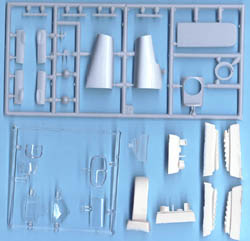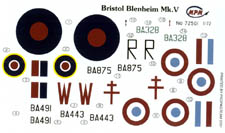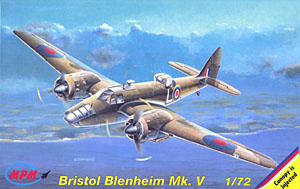MPM's 1/72 Blenheim Mk. V | | History The Blenheim Mk. V was the last version in the Blenheim lineup and while it was probably the best of the Blenheims, by the time it arrived it was already obsolete. The basic role of the Blenheim Mk. V was that of ground attack and initially it was assigned the name Bisley. The main difference between the Mk. IV and the Mk. V was the streamlined nose. The Mk. V also had a twin-gun rear upper turret and an improved, armored cockpit canopy. Originally the plane had a hard nose, but this was replaced with a bomber nose with flat panels on one half, giving the plane a decidedly odd appearance at certain angles. New Mercury XV engines and a Frazer-Nash lower turret finish the differences, but by the time all the changes were incorporated and the Bisley/Blenheim V made it to front line units, they were no match for German & Italian fighters of the time, and were soon replaced with Baltimores. Nearly all of the 940 Blenheim Mk. Vs built served in Africa and the Mediterranean, with a handful ending up in Free French hands. The Kit This latest release from MPM rounds out their Blenheim lineup (see MPM's Blenheim Mk. I and Blenheim Mk. IV reviews for more information) and as such the majority of the parts are the same as those in the other two releases. Since there's quite a few differences between the Mk. V and the previous marks, this kit has more parts than the others. A new sprue provides the new nose & assorted bits, while resin adds a pile more. A new clear sprue rounds out the differences.  Starting with the new nose, this kit provides the majority in gray plastic, with just the nose tip, windscreen and left upper section being provided in clear. This is different from the other kits, which provided the whole nose in clear. The odd shape of the nose tip made this layout necessary, and MPM does a great job of depicting this. A new cockpit floor is provided, but the majority of the other interior pieces are the same as in the earlier releases. The combination of plastic, resin and PE should make the interior look really nice and about the only additions you'll want to put in is perhaps some sidewall detailing. Starting with the new nose, this kit provides the majority in gray plastic, with just the nose tip, windscreen and left upper section being provided in clear. This is different from the other kits, which provided the whole nose in clear. The odd shape of the nose tip made this layout necessary, and MPM does a great job of depicting this. A new cockpit floor is provided, but the majority of the other interior pieces are the same as in the earlier releases. The combination of plastic, resin and PE should make the interior look really nice and about the only additions you'll want to put in is perhaps some sidewall detailing.
The other main difference between the Blenheim Mk. IV and the Mk. V deals with the wings, or more specifically the engines & nacelles. The first bit you'll have to do is cut away part of the wheel well opening, as the Mk. V had full wheel doors rather than the partial ones seen on the earlier marks. These doors are included in injection plastic, along with one of the nacelle differences, the exhaust stacks. There's actually two parts to these exhaust stacks, with the second hedgehog part being provided in resin. Other resin pieces include a scoop on the underside of the nacelle, wing leading edge scoops, and the belly gun pack. There's also a clear resin ADF football to put on top of the fuselage.  The decal sheet provides markings for four Blenheim Mk. V, three British and one French. The decals are printed by Propagteam and are thin, with perfect register. The first British option is one out of Egypt, coded white L. The camouflage is dark earth and middlestone over azure blue. The second example is also from the desert, this one being VC holder Wing Commander H. G. Malcolm's Mk. V from No 18 Squadron. This example is also in dark earth and middlestone over azure blue. A red W is the only individual markings on this example. The third desert example is a Free French example, also in desert colors, based out of Syria. This is the only example that has problems with the decals, mainly being the shade of red in the roundels and fin flash. MPM used the same color as the dull red in the British roundels, which is definitely the wrong color for French roundels. The final example is listed as being with the Royal Hellenic Air Force, No. 13 Squadron, but the plane carries standard British roundels & codes. It is finished in the maritime scheme of extra dark sea gray and dark slate gray over white, with the demarcation high up on the fuselage. The decal sheet provides markings for four Blenheim Mk. V, three British and one French. The decals are printed by Propagteam and are thin, with perfect register. The first British option is one out of Egypt, coded white L. The camouflage is dark earth and middlestone over azure blue. The second example is also from the desert, this one being VC holder Wing Commander H. G. Malcolm's Mk. V from No 18 Squadron. This example is also in dark earth and middlestone over azure blue. A red W is the only individual markings on this example. The third desert example is a Free French example, also in desert colors, based out of Syria. This is the only example that has problems with the decals, mainly being the shade of red in the roundels and fin flash. MPM used the same color as the dull red in the British roundels, which is definitely the wrong color for French roundels. The final example is listed as being with the Royal Hellenic Air Force, No. 13 Squadron, but the plane carries standard British roundels & codes. It is finished in the maritime scheme of extra dark sea gray and dark slate gray over white, with the demarcation high up on the fuselage.
Conclusion It was only a matter of time before this variant of Blenheim was released by MPM. While there are some shortcomings with the series they look like Blenheims when finished and all three will make for an interesting collection. References There are plenty of references out there on the Blenheim (old Profile Publication, Squadron In Action, etc), but the most interesting bit I read was a piece in the January 1997 issue of Airpower covering the Blenheim, Beaufort and Beaufighter. While the coverage on the Mk. V Blenheim is slight, the history of the whole airframe and how it developed into the Beaufighter is a fascinating story. | 


 




|
